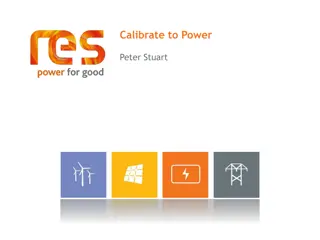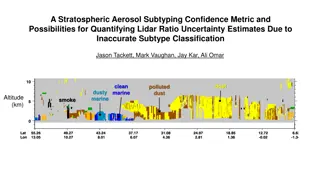Indoor Positioning Using OCC and LiDAR for Enhanced Navigation
Location-based services have gained significance, especially in indoor environments where GPS is unavailable. This submission explores incorporating Optical Camera Communication (OCC) and LiDAR to improve indoor positioning accuracy. By leveraging sensor fusion technology, the system aims to provide precise location data for seamless navigation, benefiting both individuals and autonomous systems within indoor spaces.
Download Presentation

Please find below an Image/Link to download the presentation.
The content on the website is provided AS IS for your information and personal use only. It may not be sold, licensed, or shared on other websites without obtaining consent from the author.If you encounter any issues during the download, it is possible that the publisher has removed the file from their server.
You are allowed to download the files provided on this website for personal or commercial use, subject to the condition that they are used lawfully. All files are the property of their respective owners.
The content on the website is provided AS IS for your information and personal use only. It may not be sold, licensed, or shared on other websites without obtaining consent from the author.
E N D
Presentation Transcript
January 2024 DCN 15-24-0036-00-0000 Project: IEEE P802.15 Working Group for Wireless Personal Area Networks (WPANs) Submission Title: Indoor Positioning using OCC and LiDAR Date Submitted: January 14, 2024 Source: Ida Bagus Krishna Yoga Utama, Nguyen Ngoc Huy, Yeong Min Jang [Kookmin University] Address: Kookmin University, 77 Jeongneung-Ro, Seongbuk-Gu, Seoul, 02707, Republic of Korea Voice: +82-2-910-5068 E-Mail: yjang@kookmin.ac.kr Re: Abstract: Present the use case of OCC for indoor positioning Purpose: Presentation for contribution on IEEE 802.15 IG NG-OCC Notice: This document has been prepared to assist the IG NG-OCC. It is offered as a basis for discussion and is not binding on the contributing individual(s) or organization(s). The material in this document is subject to change in form and content after further study. The contributor(s) reserve(s) the right to add, amend or withdraw material contained herein. Release: The contributor acknowledges and accepts that this contribution becomes the property of IEEE and may be made publicly available by IG NG-OCC. Slide 1 Yeong Min Jang Submission
January 2024 DCN 15-24-0036-00-0000 Indoor Positioning using OCC and LiDAR January 14, 2024 Slide 2 Yeong Min Jang Submission
January 2024 DCN 15-24-0036-00-0000 Contents Background Methodology Experiment Results Conclusion Slide 3 Yeong Min Jang Submission
January 2024 DCN 15-24-0036-00-0000 Background Location-based services becomes important in recent years. The location information is important to provide easier navigation for the movement of people and autonomous systems. In outdoor environment, the positioning is mostly taken care by utilizing a GPS systems. However, in indoor environment, the GPS is not available. To provide indoor localization, the OCC can be integrated with sensor fusion of camera-LiDAR. Slide 4 Yeong Min Jang Submission
January 2024 DCN 15-24-0036-00-0000 Methodology To this day, the VLC-based indoor localization is only performed in 2-D or with fixed ceiling height. Employing LiDAR and IMU sensor can help to establish a 3-D indoor positioning. The LIDAR provide a real-time ceiling height estimation to generate the location in a 3-D space. The VLC will provide the 2-D positioning with centimeter-scale accuracy. The IMU sensor helps improving the VLC performance by estimating the angle-of-attack of the VLC rays respective to the camera reception. The main goal is to establish a truly 3D visible light positioning (VLP) system based on a single LED transmitter. Slide 5 Yeong Min Jang Submission
January 2024 DCN 15-24-0036-00-0000 Methodology How it works? A VLC system based on angle-of- arrival (AOA) is utilized to determine the position information. The AOA information is decoded from the captured high frame rate video meanwhile tilt angle from gravity sensor is used to make corrections to the estimated AOA information. Height measure from LiDAR and AOA information is used to estimate the locations in a 3-D space. Rolling shutter effect is utilized to decode the transmitted signal. <Estimating position based on AOA and ceiling height information> Slide 6 Yeong Min Jang Submission
January 2024 DCN 15-24-0036-00-0000 Methodology <Overall scenario for indoor localization with VLC as the main technology> Data from the three sensors are timestamped and synchronized for estimating the location. The location is estimated with respect to the transmitter and the transmitter s location with respect to the global coordinate system is known. The VLC is using low-resolution high fps camera to capture the image and computer vision techniques is used for estimating the AOA. The AOA, tilt angle, and measured height information are fused to calculate the position in the 3-D space. Slide 7 Yeong Min Jang Submission
January 2024 DCN 15-24-0036-00-0000 Methodology When the device is laying flat, the AOA for point P can be expressed as: When the condition is not stationary, the AOA can be calculated by finding the tilt compensated angle that can be calculated from the gravity sensor. <Principle of AOA estimation> Slide 8 Yeong Min Jang Submission
January 2024 DCN 15-24-0036-00-0000 Methodology Then, the second AOA point can be calculated using the following equation: From the aforementioned calculation, the location in spherical coordinate (r, , ) can be retrieved Conversion to Cartesian coordinates can be done using the following equation <Principle of AOA estimation> Slide 9 Yeong Min Jang Submission
January 2024 DCN 15-24-0036-00-0000 Experiment The experiment is performed in an indoor environment using the following devices and settings: 1. OCC transmitter: 10W and 5W LED 2. OCC receiver: Galaxy S9 3. LiDAR: Benewake TFmini-S 4. OCC frame 128x72 5. OCC frame rate: 960 fps 6. Packet size: 10-bit 7. Modulation: OOK Samsung resolution: <Experiment setup> Slide10 Yeong Min Jang Submission
January 2024 DCN 15-24-0036-00-0000 Results The experiment is performed in a room with size of 2.5 m x 1.5 m x 3 m using single LED. The maximum error toward X, Y, and Z directions are 9.8 cm, 8.47, and 6 cm respectively. The average error toward X, Y, and Z directions are 5.3 cm, 5.6, and 0.9 cm respectively. The average positioning errors in the 3D space is 6.8 cm. <Experiment results and errors> Slide 11 Yeong Min Jang Submission
January 2024 DCN 15-24-0036-00-0000 Results The experiment is performed in a room with size of 2.5 m x 1 m x 2 m using two LEDs. The experiment is conducted twice, static readings and with the user walked on a straight-line path. The cumulative distribution function (CDF) of the positioning errors with 80% error values in X and Y direction is under 7 cm and 4.5 cm, respectively. The average error in Z direction is below 1 cm due to the usage of LiDAR. The straight walking path has average errors of 4 cm and maximum errors of 10 cm. <Experiment results and errors> Slide12 Yeong Min Jang Submission
January 2024 DCN 15-24-0036-00-0000 Conclusion A 3-D visible light positioning system using a very low-resolution high fps and LiDAR has been proposed. The low resolution and high fps is effective to achieve centimeter-scale positioning accuracy. By equipping a LiDAR sensor, the height ambiguity is solved and able to achieve an accurate Z direction estimation. The usage of tilt angle from IMU sensor improve the robustness of AOA estimation. Additionally, the combination of AOA with LiDAR measurement is able to produce an accurate indoor positioning system. Slide13 Yeong Min Jang Submission
January 2024 DCN 15-24-0036-00-0000 Reference 1. K. Bera, R. Parthiban, and N. Karmakar, A Truly 3D Visible Light Positioning System Using Low Resolution High Speed Camera, LIDAR, and IMU Sensors, IEEE Access, vol. 11, pp. 10.1109/access.2023.3312293. 98578 98585, 2023, doi: Slide14 Yeong Min Jang Submission























